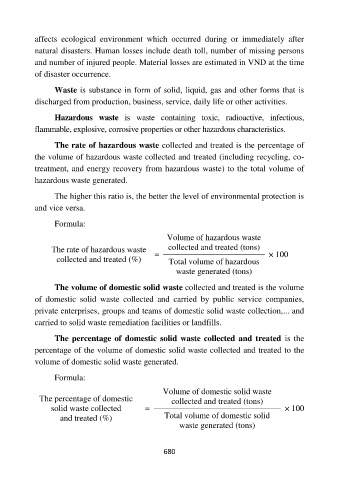Page 680 - index
P. 680
affects ecological environment which occurred during or immediately after
natural disasters. Human losses include death toll, number of missing persons
and number of injured people. Material losses are estimated in VND at the time
of disaster occurrence.
Waste is substance in form of solid, liquid, gas and other forms that is
discharged from production, business, service, daily life or other activities.
Hazardous waste is waste containing toxic, radioactive, infectious,
flammable, explosive, corrosive properties or other hazardous characteristics.
The rate of hazardous waste collected and treated is the percentage of
the volume of hazardous waste collected and treated (including recycling, co-
treatment, and energy recovery from hazardous waste) to the total volume of
hazardous waste generated.
The higher this ratio is, the better the level of environmental protection is
and vice versa.
Formula:
Volume of hazardous waste
The rate of hazardous waste = collected and treated (tons) × 100
collected and treated (%) Total volume of hazardous
waste generated (tons)
The volume of domestic solid waste collected and treated is the volume
of domestic solid waste collected and carried by public service companies,
private enterprises, groups and teams of domestic solid waste collection,... and
carried to solid waste remediation facilities or landfills.
The percentage of domestic solid waste collected and treated is the
percentage of the volume of domestic solid waste collected and treated to the
volume of domestic solid waste generated.
Formula:
Volume of domestic solid waste
The percentage of domestic collected and treated (tons)
solid waste collected = × 100
and treated (%) Total volume of domestic solid
waste generated (tons)
680

